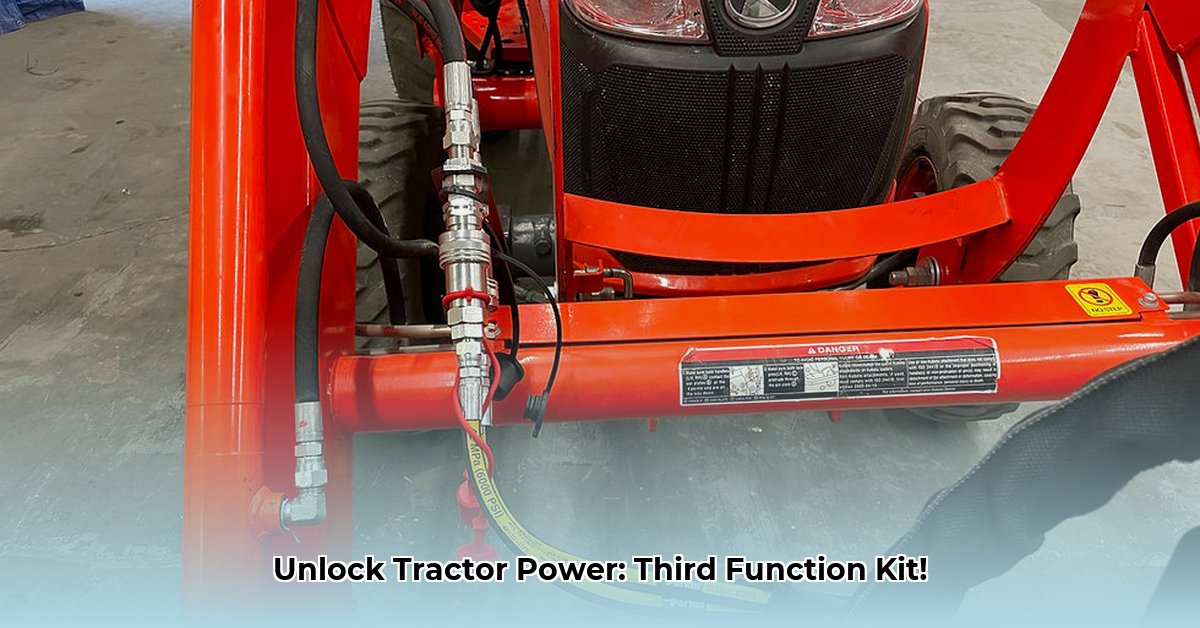
Understanding Third Function Kits: Expanding Your Tractor's Capabilities
A third function kit significantly enhances your tractor's versatility and productivity. Unlike standard tractors limited to two hydraulic functions, a third function kit adds an independent hydraulic circuit. This allows you to operate a third implement simultaneously with your primary attachments, essentially giving your tractor an extra set of "hydraulic hands." But how does this translate into real-world benefits? Isn't this just another expensive accessory? Let's dive into the details. For more on expanding your tractor's capabilities, check out this helpful resource on tractor attachments.
The Benefits of a Third Function Kit: Time Saved, Money Earned
The advantages of a third function kit extend beyond simple convenience. They offer a tangible return on investment through increased efficiency and expanded operational capabilities. Did you know that a significant portion of farm labor costs are attributed to equipment downtime and inefficient workflows?
- Drastically Increased Productivity: Multitasking with attachments becomes effortless, allowing you to accomplish more in less time. Imagine simultaneously using a front-end loader and a grapple: the potential to streamline operations is immense.
- Enhanced Versatility: A wider range of implements becomes compatible with your tractor, opening doors to a greater variety of tasks and applications. This expanded functionality increases the overall utility of your machinery.
- Significant Cost Savings: By completing jobs more quickly and efficiently, you can reduce labor costs and potentially increase your profitability. The initial investment quickly pays for itself through streamlined workflows and reduced downtime. Consider this: How much time do you currently spend switching between attachments?
But what about the potential drawbacks? Let's also be realistic and acknowledge the costs and complexities associated with installing this tool.
Choosing the Right Third Function Kit: A Personalized Approach
Selecting the right kit necessitates careful consideration of several key factors. The "one-size-fits-all" approach rarely works. Matching the kit's specifications to your tractor and operational requirements is critical. Failing to do so could lead to poor performance, decreased efficiency, or even potential damage to your equipment.
| Feature | Considerations |
|---|---|
| Flow Rate (gallons per minute) | The volume of hydraulic fluid required by your implements. Higher flow rates are needed for more demanding tasks. |
| Control Type (Joystick, Buttons, etc.) | User preference and ergonomics; different control schemes offer varying levels of comfort and precision. |
| Tractor Compatibility | Absolutely essential! Check compatibility with your specific tractor model and year. |
| Budget | Kits range significantly in price; establish a budget before you begin your search. |
Installation: A Step-by-Step Guide to Success
Installing a third function kit isn't always a simple DIY project. If you lack hydraulic system experience, it's best to seek professional help; incorrect installation can lead to malfunctions or even safety hazards. However, for the mechanically inclined, here is a general overview (Always consult your specific kit's instructions and your tractor's manual).
Step-by-Step Installation:
- Safety First: Disconnect the tractor battery before starting any work.
- Preparation: Gather required tools and carefully review instructions.
- Assembly: Mount the valve block (the heart of the kit) according to the manufacturer's specifications.
- Hydraulic Connections: Connect the hydraulic lines correctly and securely, paying close attention to avoid kinks or damage.
- Control Mechanism Installation: Install and configure the control lever in an easily accessible and ergonomic position.
- System Bleeding: Remove air from the hydraulic lines to ensure proper system function.
- Testing: Before fully operational use, rigorously test the system to ensure everything is functioning correctly. Reconnect the battery.
Weighing the Pros and Cons: A Balanced Perspective
Before making a final decision, consider both the advantages and disadvantages. The overall cost-benefit analysis will vary based on your individual farming operation.
Pros:
- Dramatically Increased Productivity: Multi-tasking potential.
- Expanded Operational Capabilities: Ability to use a much wider range of implements.
- Cost Savings long term: Ultimately, reducing manual labor requirements and minimizing downtime.
Cons:
- Upfront Investment: Purchasing and installation will incur some expense.
- Increased System Complexity: Your tractor's hydraulic system will become more intricate.
- Potential Need for Professional Installation: This adds to the overall cost.
A third function kit can be a game-changer for improving tractor efficiency and enhancing your farming operations. However, careful planning and consideration of your specific needs are crucial before making an investment. Thorough research, understanding your tractor's capabilities, and weighing the pros and cons will pave the way for a successful upgrade.